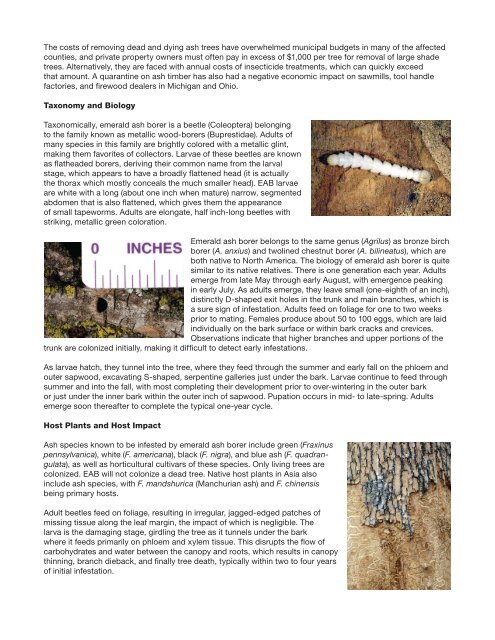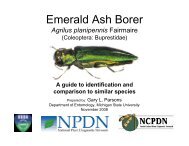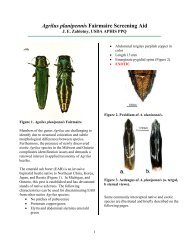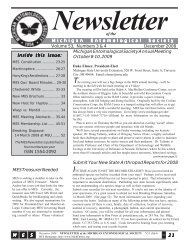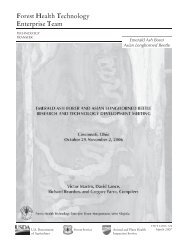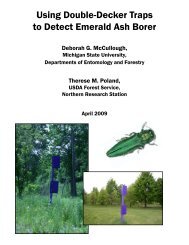Create successful ePaper yourself
Turn your PDF publications into a flip-book with our unique Google optimized e-Paper software.
The costs of removing dead and dying ash trees have overwhelmed municipal budgets in many of the affected<br />
counties, and private property owners must often pay in excess of $1,000 per tree for removal of large shade<br />
trees. Alternatively, they are faced with annual costs of insecticide treatments, which can quickly exceed<br />
that amount. A quarantine on ash timber has also had a negative economic impact on sawmills, tool handle<br />
<strong>fact</strong>ories, and firewood dealers in Michigan and Ohio.<br />
Taxonomy and Biology<br />
Taxonomically, emerald ash borer is a beetle (Coleoptera) belonging<br />
to the family known as metallic wood-borers (Buprestidae). Adults of<br />
many species in this family are brightly colored with a metallic glint,<br />
making them favorites of collectors. Larvae of these beetles are known<br />
as flatheaded borers, deriving their common name from the larval<br />
stage, which appears to have a broadly flattened head (it is actually<br />
the thorax which mostly conceals the much smaller head). EAB larvae<br />
are white with a long (about one inch when mature) narrow, segmented<br />
abdomen that is also flattened, which gives them the appearance<br />
of small tapeworms. Adults are elongate, half inch-long beetles with<br />
striking, metallic green coloration.<br />
<strong>Emerald</strong> ash borer belongs to the same genus (Agrilus) as bronze birch<br />
borer (A. anxius) and twolined chestnut borer (A. bilineatus), which are<br />
both native to North America. The biology of emerald ash borer is quite<br />
similar to its native relatives. There is one generation each year. Adults<br />
emerge from late May through early August, with emergence peaking<br />
in early July. As adults emerge, they leave small (one-eighth of an inch),<br />
distinctly D-shaped exit holes in the trunk and main branches, which is<br />
a sure sign of infestation. Adults feed on foliage for one to two weeks<br />
prior to mating. Females produce about 50 to 100 eggs, which are laid<br />
individually on the bark surface or within bark cracks and crevices.<br />
Observations indicate that higher branches and upper portions of the<br />
trunk are colonized initially, making it difficult to detect early infestations.<br />
As larvae hatch, they tunnel into the tree, where they feed through the summer and early fall on the phloem and<br />
outer sapwood, excavating S-shaped, serpentine galleries just under the bark. Larvae continue to feed through<br />
summer and into the fall, with most completing their development prior to over-wintering in the outer bark<br />
or just under the inner bark within the outer inch of sapwood. Pupation occurs in mid- to late-spring. Adults<br />
emerge soon thereafter to complete the typical one-year cycle.<br />
Host Plants and Host Impact<br />
<strong>Ash</strong> species known to be infested by emerald ash borer include green (Fraxinus<br />
pennsylvanica), white (F. americana), black (F. nigra), and blue ash (F. quadrangulata),<br />
as well as horticultural cultivars of these species. Only living trees are<br />
colonized. EAB will not colonize a dead tree. Native host plants in Asia also<br />
include ash species, with F. mandshurica (Manchurian ash) and F. chinensis<br />
being primary hosts.<br />
Adult beetles feed on foliage, resulting in irregular, jagged-edged patches of<br />
missing tissue along the leaf margin, the impact of which is negligible. The<br />
larva is the damaging stage, girdling the tree as it tunnels under the bark<br />
where it feeds primarily on phloem and xylem tissue. This disrupts the flow of<br />
carbohydrates and water between the canopy and roots, which results in canopy<br />
thinning, branch dieback, and finally tree death, typically within two to four years<br />
of initial infestation.


